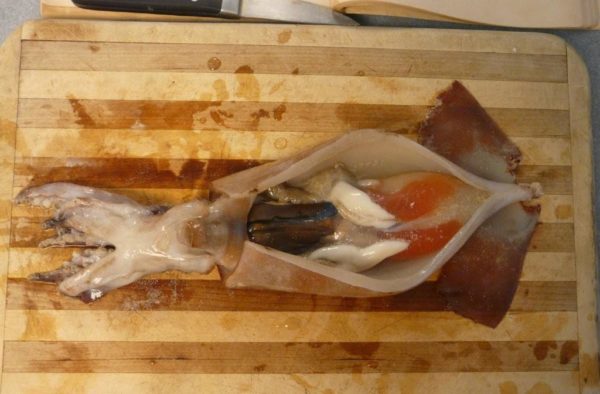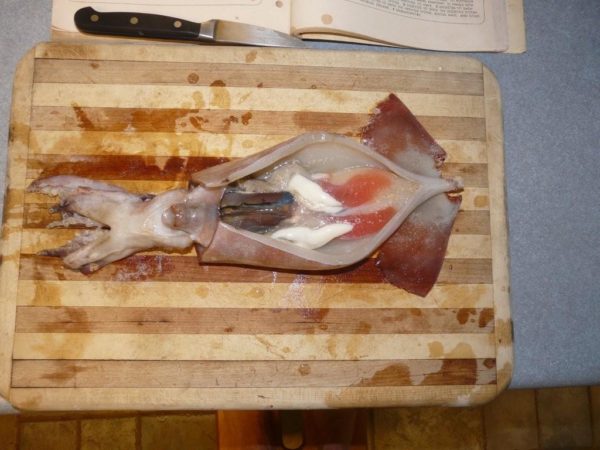Published in the Ocean Watch column, Honolulu Star-Advertiser © Susan Scott
Friday, November 14, 2008
Last week Craig returned from a run on Lanikai Beach and told me a cuttlefish had washed ashore. Or maybe it was a squid. He didn’t know for sure.
That was the end of answering my e-mail. Down to the beach I went to check it out.
It was a squid. I knew this because this freshly dead individual was a classic: 12-inch-long tubular body, two short fins at the tail end and rusty red in color. The hefty squid was so beautiful, in its space-alien kind of way, I carried it home, dripping squid ink on my shoes and the dog all the way there.
Alive and in the water, squid and cuttlefish look different, but since their body parts are so similar, I wasn’t sure whether they would be so distinct lying dead on a beach. They are.
With about 100 species of cuttlefish and 300 species of squid in the world, appearances vary widely, but in general the main difference between the two is body shape and fins.
Cuttlefish have short, broad, flat bodies containing the familiar cuttlebone, with a frilly fin running all the way around. Squid have tubelike bodies containing a soft bone descriptively called a pen, with a pair of triangular fins that make the tail end of the squid resemble an arrowhead.
After that, cuttlefish and squid have much in common with each other and with their close cousins the octopuses.
The three belong to a group called cephalopods, meaning head-footed, because the creatures’ heads and feet, the terms being used extremely loosely, are located in the same area.
At the head end of these creatures is a mouth that looks and works like a raptor’s beak. Eight appendages (called arms, not feet or legs — go figure) surround the mouth along with two longer tentacles.
All 10 of these agile appendages bear sticky suction cups. Those of my dead squid stuck to my fingers.
Directly behind the tentacles and arms is a pair of eyes, well developed to spot prey. When a meal is within reach, the two tentacles make a lightning strike to grab it, and then the arms hold it to the mouth.
Like birds of prey beaks, squid beaks also tear off pieces of their captured animal. Typically, a squid darts into a school of small fish, seizes one with its tentacles and bites the head off. A tonguelike organ pulls the meat inside the mouth, and the creature swallows.
Open-ocean squid eat mostly fish, but when fish are scarce, squid eat each other.
Cuttlefish have a different hunting method, lying in wait or swimming slowly over the ocean floor to snap up shrimp and crabs.
Squid and cuttlefish are famous for changing color. Some flash bright colors during mating time, and most can change color to match their backgrounds. All have an ink sac containing black or brown fluid. When threatened, the animal shoots out a cloud of this ink to confuse predators while the squid makes its getaway.
My squid’s ink washed out of my Crocs but stained my dog’s leash.
Just about every marine predator eats squid, and we terrestrials like it, too. When it’s food, we call it the Italian word for squid, calamari.
As I examined my squid’s weird and wonderful body, it seemed reasonable that science-fiction filmmakers so often make their space monsters resemble squid. These head-footed, hawk-beaked, suction-cupped creatures are out of this world.

